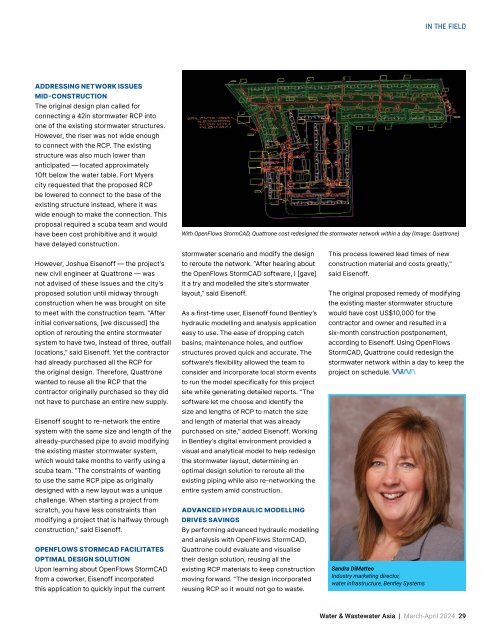Water & Wastewater Asia March/April 2024
Water & Wastewater Asia is an expert source of industry information, cementing its position as an indispensable tool for trade professionals in the water and wastewater industry. As the most reliable publication in the region, industry experts turn this premium journal for credible journalism and exclusive insight provided by fellow industry professionals. Water & Wastewater Asia incorporates the official newsletter of the Singapore Water Association (SWA).
Water & Wastewater Asia is an expert source of industry information, cementing its position as an indispensable tool for trade professionals in the water and wastewater industry. As the most reliable publication in the region, industry experts turn this premium journal for credible journalism and exclusive insight provided by fellow industry professionals. Water & Wastewater Asia incorporates the official newsletter of the Singapore Water Association (SWA).
Create successful ePaper yourself
Turn your PDF publications into a flip-book with our unique Google optimized e-Paper software.
IN THE FIELD<br />
ADDRESSING NETWORK ISSUES<br />
MID-CONSTRUCTION<br />
The original design plan called for<br />
connecting a 42in stormwater RCP into<br />
one of the existing stormwater structures.<br />
However, the riser was not wide enough<br />
to connect with the RCP. The existing<br />
structure was also much lower than<br />
anticipated — located approximately<br />
10ft below the water table. Fort Myers<br />
city requested that the proposed RCP<br />
be lowered to connect to the base of the<br />
existing structure instead, where it was<br />
wide enough to make the connection. This<br />
proposal required a scuba team and would<br />
have been cost prohibitive and it would<br />
have delayed construction.<br />
However, Joshua Eisenoff — the project’s<br />
new civil engineer at Quattrone — was<br />
not advised of these issues and the city’s<br />
proposed solution until midway through<br />
construction when he was brought on site<br />
to meet with the construction team. “After<br />
initial conversations, [we discussed] the<br />
option of rerouting the entire stormwater<br />
system to have two, instead of three, outfall<br />
locations,” said Eisenoff. Yet the contractor<br />
had already purchased all the RCP for<br />
the original design. Therefore, Quattrone<br />
wanted to reuse all the RCP that the<br />
contractor originally purchased so they did<br />
not have to purchase an entire new supply.<br />
Eisenoff sought to re-network the entire<br />
system with the same size and length of the<br />
already-purchased pipe to avoid modifying<br />
the existing master stormwater system,<br />
which would take months to verify using a<br />
scuba team. “The constraints of wanting<br />
to use the same RCP pipe as originally<br />
designed with a new layout was a unique<br />
challenge. When starting a project from<br />
scratch, you have less constraints than<br />
modifying a project that is halfway through<br />
construction,” said Eisenoff.<br />
OPENFLOWS STORMCAD FACILITATES<br />
OPTIMAL DESIGN SOLUTION<br />
Upon learning about OpenFlows StormCAD<br />
from a coworker, Eisenoff incorporated<br />
this application to quickly input the current<br />
With OpenFlows StormCAD, Quattrone cost redesigned the stormwater network within a day (Image: Quattrone)<br />
stormwater scenario and modify the design<br />
to reroute the network. “After hearing about<br />
the OpenFlows StormCAD software, I [gave]<br />
it a try and modelled the site’s stormwater<br />
layout,” said Eisenoff.<br />
As a first-time user, Eisenoff found Bentley’s<br />
hydraulic modelling and analysis application<br />
easy to use. The ease of dropping catch<br />
basins, maintenance holes, and outflow<br />
structures proved quick and accurate. The<br />
software’s flexibility allowed the team to<br />
consider and incorporate local storm events<br />
to run the model specifically for this project<br />
site while generating detailed reports. “The<br />
software let me choose and identify the<br />
size and lengths of RCP to match the size<br />
and length of material that was already<br />
purchased on site,” added Eisenoff. Working<br />
in Bentley’s digital environment provided a<br />
visual and analytical model to help redesign<br />
the stormwater layout, determining an<br />
optimal design solution to reroute all the<br />
existing piping while also re-networking the<br />
entire system amid construction.<br />
ADVANCED HYDRAULIC MODELLING<br />
DRIVES SAVINGS<br />
By performing advanced hydraulic modelling<br />
and analysis with OpenFlows StormCAD,<br />
Quattrone could evaluate and visualise<br />
their design solution, reusing all the<br />
existing RCP materials to keep construction<br />
moving forward. “The design incorporated<br />
reusing RCP so it would not go to waste.<br />
This process lowered lead times of new<br />
construction material and costs greatly,”<br />
said Eisenoff.<br />
The original proposed remedy of modifying<br />
the existing master stormwater structure<br />
would have cost US$10,000 for the<br />
contractor and owner and resulted in a<br />
six-month construction postponement,<br />
according to Eisenoff. Using OpenFlows<br />
StormCAD, Quattrone could redesign the<br />
stormwater network within a day to keep the<br />
project on schedule.<br />
Sandra DiMatteo<br />
Industry marketing director,<br />
water infrastructure, Bentley Systems<br />
<strong>Water</strong> & <strong>Wastewater</strong> <strong>Asia</strong> | <strong>March</strong>-<strong>April</strong> <strong>2024</strong> 29

















